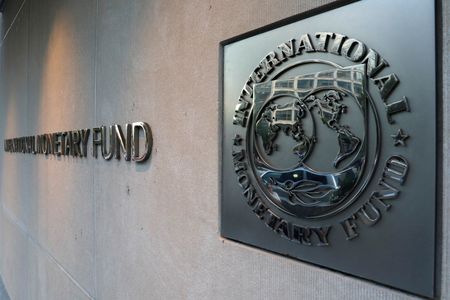By Andrea Shalal
WASHINGTON (Reuters) -More work is needed to improve the sovereign debt restructuring process and help countries facing mounting debt service challenges, the chairs of a global debt roundtable said on Wednesday, as they released a new playbook to aid those efforts.
The Global Sovereign Debt Roundtable, formally launched in late 2022 to help accelerate progress on securing debt treatment for countries in default, met Wednesday during the spring meetings of the International Monetary Fund and the World Bank.
Co-chaired by the IMF, the World Bank and South Africa, current chair of the Group of 20 major economies, it includes creditors, borrowing countries, private sector executives, debt experts, and financial and legal advisers.
Co-chairs on Wednesday cited some progress on aspects for the debt restructuring process, including the clarification that debtor countries undergoing a restructuring but not in arrears to official bilateral creditors can request a suspension of their debt service payments. Debtor countries had pressed for assurance that such debt relief could be made available.
Ceyla Pazarbasioglu, the IMF’s strategy chief, said debt stability risks in emerging markets and developing economies were broadly contained, but the uncertainty around that baseline had increased “very substantially” given rising trade tensions.
“There are lots of headwinds, a lot of policy uncertainty,” she told reporters, citing challenges for countries with high exports and exposure to U.S. tariffs, declining commodity prices, tightening financial conditions and declining growth.
Pazarbasioglu said there was an urgent need to address the high debt service burden facing many countries, a situation that she said was getting more acute in the current environment.
The IMF on Wednesday announced that economic pressures from steep new U.S. tariffs will push global public debt above pandemic-era levels to nearly 100% of global GDP by the end of the decade as slower growth and trade strain government budgets.
The IMF’s latest Fiscal Monitor projected that global public debt will grow 2.8 percentage points to 95.1% of global GDP in 2025, reaching 99.6% of global GDP by 2030.
MORE WORK NEEDED TO RESTRUCTURE DEBT
Public debt levels in low-income countries and emerging markets were already high before the COVID-19 pandemic and then rose, but they have stabilized since and look set to decline slightly or remain stable over the medium term.
A few countries remained particularly vulnerable and many countries face elevated debt service challenges, with high interest costs and refinancing needs crowding out spending on education, health and infrastructure investment.
Citing ongoing challenges, the co-chairs called for further work to improve restructuring processes, including the G20 Common Framework; efforts to help countries whose debt is sustainable but are faced with elevated debt service challenges; and work to prevent a future unsustainable build-up of debt.
This would require “advancing robust progress on debt transparency, debt management, and debtor/investor relations,” the co-chairs wrote in their progress report.
They said the new playbook released Wednesday was a “user-friendly document” that summarized the key steps, concepts and processes observed in recent sovereign debt restructurings.
Pazarbasioglu said the playbook was intended to be “a living document” that could be updated continually. It sets out a path that would see restructurings completed in a period of one year.
The playbook is non-binding, and recognizes that each case may have its own specificities and complexities, she added.
Discussions among the global debt roundtable underlined the need for enhanced transparency and information sharing regarding restructuring agreements reached by official creditor committees. Participants also discussed the bottlenecks that can delay post-restructuring credit rating upgrades.
Pazarbasioglu said the roundtable had made some progress on the issue of non-bonded commercial debt and would continue looking at that closely, along with efforts to accelerate timelines, improve transparency and data-sharing.
(Reporting by Andrea Shalal; Editing by Leslie Adler and Sonali Paul)








